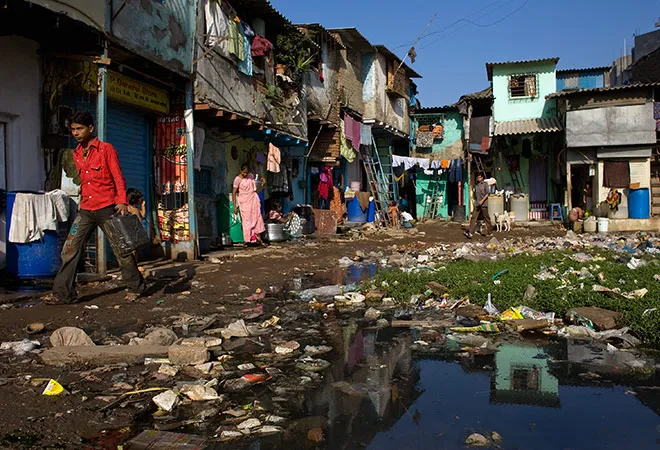-
CENTRES
Progammes & Centres
Location

Image Source: Daniel Berehulak/Getty Images
Dwellers going about their daily routine in Dharavi
If you type the words “slum tours” on the popular travel website Tripadvisor, you will find numerous pictures of smiling, well-dressed tourists with their arms around locals, with ramshackle slums in the backdrop. The pictures are generally of foreigners on “slum tourism,” a concept that can be traced to the act of “slumming” in the 1860s – added to the Oxford Dictionary at the time and meant “to go into, or frequent, slums for discreditable purposes; to saunter about, with a suspicion, perhaps, of immoral pursuits.” Slumming became a routine activity when rich Londoners braved the city’s notorious East End in the 1840s, and brought the practice to New York City as a form of amusement to compare slums abroad. Oxford and Cambridge Universities used this concept to understand underprivileged neighbourhoods and inform nineteenth century social policy by witnessing the areas first-hand.
Today, the internet definition of slumming is to “spend time at a lower social level than one's own through curiosity or for charitable purposes,” aptly describing the phenomenon of “slum tourism” prevalent in cities like Mumbai, Rio de Janeiro, Manila, and Johannesburg.
This definition lends itself to a variety of genres of interest, depending on the assortment of sites and experiences offered by destinations. Slum tours are also called reality tours, adventure tours, artisanal tours, and poverty tours and are advertised under the “niche travel” sections of several tourism portals. Slum tourism has grown into a global industry, bringing in over a million tourists per year.
Combining the essentially frivolous nature of the term ‘tourism’ with poverty and urban deprivation seems to trivialise the problem and reduce it to a zoo-like, voyeuristic cycle, where tourists are made to acknowledge their privileged existence at the cost of slumdwellers. Many official foreign visits to India, too, make visits to slums an integral part of the itinerary in order to facilitate awareness and generate funds for development. Proponents of slum tourism argue that witnessing less privileged communities raises awareness and propels individuals to give back to and/or advocate for the advancement of communities. But how can we measure how far the tourists have understood local problems, or whether they really affect concrete change? It is difficult to measure if the post-tour, guilt-ridden community involvement offsets the objectification of the poor through these tours, as well as the disruption of the day-to-day activities and right to privacy of the community members.
The Dharavi slum area of Mumbai is the second-largest slum in Asia, and the third-largest in the world. Dharavi is not a desolate and deprived community of unemployed squatters. Within the alleys of shanties there are booming home industries that sustain 20,000 small-scale units.
A New York Times mapping of the industrial slum area describes the northern 13th Compound as the heart of Dharavi’s recycling industry, where an estimated 80 percent of Mumbai’s plastic waste is recycled in approximately 15,000 single-room factories. It also describes the southern Kumbharwada region as production spaces of the migrant potters from Saurashtra. The Maharashtra Slum Redevelopment Authority (SRA) describes Dharavi’s growth as “closely interwoven with the pattern of migration into Bombay”, due to the land being free and unregulated. Together with Muslim tanners from Tamil Nadu, artisans and embroidery workers from Uttar Pradesh and several other migrants setting up businesses of savories and sweets, the area provides ample employment opportunities irrespective of region, caste, religion. The SRA also states that most of the land in Dharavi is owned by government and government agencies, making it easier to setup informal settlement.
These industries and labour are part of the informal economy – it is not taxed, it is not monitored by the government, nor is its contribution accounted for in the country’s GDP. As it is outside the purview of the government, interventions to improve the dismal infrastructure, provide sanitation, drainage, and electricity facilities are overlooked.
In order to increase awareness about the poor living conditions, there exist several profit-making Dharavi slum tours, which also claim to be facilitating the development of the community. A company founded in 2005 provides educational walking tours of Dharavi. The company claims that 80 percent of its profits go to its NGO, which runs high-quality education programmes for Dharavi residents. Another company, started by Dharavi residents, works to support local students to study full-time and also trains and employs them as tour guides.
On several global tourism portals, five-star reviews for these tours highlight their ‘awareness quotient’. The reviews range from wanting to “meet some additional locals as they were all extremely nice and friendly” to expressing surprise that there was “extreme poverty everywhere, but so much life!” Most of the “Poor” and “Terrible” reviews do not mention the nature of tourism, but rather disapprove the experience in the “dirty, congested slum”. Reviewers generally note that though there was poverty, there was no suffering and people living in the slums were happy. Dr. Melissa Nisbett, who analysed more than 230 such reviews, concluded that for most Dharavi visitors, desolation in poverty did not exist. In her article on de-politicisation of poverty, her analyses of the reviews show that “poverty was ignored, denied, overlooked and romanticised, but moreover, it was de-politicised.” Without discussing the reason behind why the slum existed, the tour de-contextualised the plight of the poor and seemed only to empower the privileged, she notes. Dr. Fabian Frenzel, on the other hand, argues that since poverty lacks recognition and voice, tourism provides the audience for a much-needed story to be told, and even “taking the most commodifying tour is better than ignoring that inequality completely.”
One of the main slum tour operators in Dharavi is not based in the area. Instead, it ropes in locals to lead the tours. It’s website gloats Dharavi’s thriving industry.
Dharavi is portrayed as the hub that “supplies celebrations for a century” (through handcrafted idols and sweets), “the height of fashion” (the second-largest leather apparel industry in India), and the birth of “Swachh Bharat Abhiyaan” (due to 80 percent of the city’s plastic being recycled here). The website goes on to describe how several tourists have been “inspired” by visiting these successful industries “in the midst of derelict conditions”. This is an inept description, as it obscures the slums’ crying need to improve its living conditions. The company claims that “bulldozing
Slum tours are the perfect example of a vicious cycle where the run-down aspects of a community are commercialised. The community benefits from the tours, and therefore, does not actively participate to improve the community. While infrastructure development projects are at a standstill due to the informal nature of the activities, the untaxed nature of informal activity is also beneficial to the poor artisans. These factors have led to a community that has been willingly or unwillingly embedded into an ethically-inappropriate but financially-viable rigmarole.
The government needs to find viable alternatives for employment and housing for such communities – alternatives that support its prosperous industry, while also covering the opportunity cost of eradicating slum tourism. Most of the slum redevelopment schemes under SRA are along the major developed roads of Dharavi, while no major schemes are proposed in the interior parts due to inadequate access and also due to the presence of larger number of commercial units. There are currently about 100 construction projects in Dharavi, which mainly are limited to housing. However, such redevelopment must ensure that the existing industrial infrastructure is also refurbished, as tenants are likely to reject housing that does not have an environment for income-generation, and therefore, is unsustainable. These large number of industrial units need to be developed along with the construction of housing projects, construction of roads, better access points along with provision of civic amenities like water and sanitation.
The denizens of Dharavi have commercial opportunities and should not be living in the squalor that slum tours glorify and sustain. It will be tough to bring the informal activities under the purview of taxable labour and income – the government will face stiff opposition, distrust, and backlash.
However, hand-holding the community through the process by providing examples of successful redevelopment projects, the importance of basic infrastructure (hygiene, sanitation, electricity, housing), and ensuring that there is no loss to the ingenious industry is essential. Slum tourism can be eradicated if the people are empowered with good civic amenities along with housing and the workplaces.
Slum tours aim to dispel notions that people may have of slums being a place of misery; but the main aim should be to eliminate disparity and adversity, not showcase what has happened despite it. While citizens of the area might seem to benefit from these tours, finding an alternative form of development in terms of industry and employment is essential in order to lift the community from this irony of ‘profitable’ poverty.
The views expressed above belong to the author(s). ORF research and analyses now available on Telegram! Click here to access our curated content — blogs, longforms and interviews.

Aditi Ratho was an Associate Fellow at ORFs Mumbai centre. She worked on the broad themes like inclusive development gender issues and urbanisation. ...
Read More +